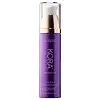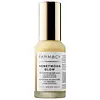What's inside
What's inside
 Key Ingredients
Key Ingredients

 Benefits
Benefits

 Concerns
Concerns

 Ingredients Side-by-side
Ingredients Side-by-side

Aloe Barbadensis Leaf Juice
Skin ConditioningLactic Acid
BufferingPersea Gratissima Oil
Skin ConditioningWater
Skin ConditioningLactobacillus Ferment
Skin ConditioningVitis Vinifera Juice Extract
AntioxidantGlycerin
HumectantGlyceryl Stearate Citrate
EmollientPotassium Hydroxide
BufferingSodium Stearoyl Glutamate
CleansingHelianthus Annuus Seed Oil
EmollientBrassica Alcohol
EmollientLactobacillus/Dipteryx Odorata Seed Ferment Filtrate
Skin ConditioningPolyglyceryl-3 Stearate
EmulsifyingLactobacillus
Skin ConditioningLysolecithin
EmulsifyingSclerotium Gum
Emulsion StabilisingXylityl Sesquicaprylate
AntimicrobialJojoba Esters
EmollientHydrogenated Lecithin
EmulsifyingPullulan
Xanthan Gum
EmulsifyingCocos Nucifera Fruit Extract
EmollientPotassium Sorbate
PreservativeCitrus Aurantium Flower Oil
PerfumingSalix Alba Bark Extract
AstringentAnhydroxylitol
HumectantMicrocitrus Australasica Fruit Extract
Tocopherol
AntioxidantLactobacillus/Lemon Peel Ferment Extract
Skin ConditioningMorinda Citrifolia Fruit Extract
Skin ConditioningSilica
AbrasiveHydrolyzed Sodium Hyaluronate
Skin ConditioningPelargonium Graveolens Flower Oil
MaskingLeuconostoc/Radish Root Ferment Filtrate
AntimicrobialAmethyst Powder
AbrasiveCitronellol
PerfumingFarnesol
PerfumingGeraniol
PerfumingLinalool
PerfumingLimonene
PerfumingAloe Barbadensis Leaf Juice, Lactic Acid, Persea Gratissima Oil, Water, Lactobacillus Ferment, Vitis Vinifera Juice Extract, Glycerin, Glyceryl Stearate Citrate, Potassium Hydroxide, Sodium Stearoyl Glutamate, Helianthus Annuus Seed Oil, Brassica Alcohol, Lactobacillus/Dipteryx Odorata Seed Ferment Filtrate, Polyglyceryl-3 Stearate, Lactobacillus, Lysolecithin, Sclerotium Gum, Xylityl Sesquicaprylate, Jojoba Esters, Hydrogenated Lecithin, Pullulan, Xanthan Gum, Cocos Nucifera Fruit Extract, Potassium Sorbate, Citrus Aurantium Flower Oil, Salix Alba Bark Extract, Anhydroxylitol, Microcitrus Australasica Fruit Extract, Tocopherol, Lactobacillus/Lemon Peel Ferment Extract, Morinda Citrifolia Fruit Extract, Silica, Hydrolyzed Sodium Hyaluronate, Pelargonium Graveolens Flower Oil, Leuconostoc/Radish Root Ferment Filtrate, Amethyst Powder, Citronellol, Farnesol, Geraniol, Linalool, Limonene
Water
Skin ConditioningLactic Acid
BufferingPropanediol
SolventJojoba Esters
EmollientGlycolic Acid
BufferingPotassium Hydroxide
BufferingSalix Alba Bark Extract
AstringentCarthamus Tinctorius Oleosomes
EmollientVitis Vinifera Seed Oil
EmollientHibiscus Sabdariffa Flower Extract
Skin ConditioningCitric Acid
BufferingHoney Extract
HumectantEchinacea Purpurea Root Extract
MoisturisingPropolis Extract
Skin ConditioningRoyal Jelly Extract
Skin ConditioningHydrolyzed Sodium Hyaluronate
Skin ConditioningHydrolyzed Hyaluronic Acid
HumectantCurcuma Longa Root Extract
MaskingArgania Spinosa Kernel Oil
EmollientZingiber Officinale Root Extract
MaskingAmaranthus Caudatus Seed Oil
EmollientLimnanthes Alba Seed Oil
Skin ConditioningVaccinium Myrtillus Fruit/Leaf Extract
AstringentSaccharum Officinarum Extract
MoisturisingCitrus Aurantium Dulcis Fruit Extract
MaskingCitrus Limon Fruit Extract
MaskingAcer Saccharum Extract
Skin ConditioningMelia Azadirachta Leaf Extract
Skin ConditioningHelianthus Annuus Seed Oil
EmollientMelia Azadirachta Flower Extract
Skin ConditioningSalvia Hispanica Seed Oil
MoisturisingCetearyl Alcohol
EmollientGlycerin
HumectantArachidyl Alcohol
EmollientSclerotium Gum
Emulsion StabilisingCoco-Glucoside
CleansingPolyacrylate Crosspolymer-6
Emulsion StabilisingBehenyl Alcohol
EmollientArachidyl Glucoside
EmulsifyingSodium Benzoate
MaskingTocopherol
AntioxidantPotassium Sorbate
PreservativeCorallina Officinalis Extract
Skin ConditioningPolyglyceryl-10 Stearate
Skin ConditioningGluconolactone
Skin Conditioning1,2-Hexanediol
Skin ConditioningOcimum Basilicum Flower/Leaf Extract
TonicOcimum Sanctum Leaf Extract
Skin ConditioningT-Butyl Alcohol
PerfumingGlucose
HumectantCalcium Gluconate
HumectantCitral
PerfumingWater, Lactic Acid, Propanediol, Jojoba Esters, Glycolic Acid, Potassium Hydroxide, Salix Alba Bark Extract, Carthamus Tinctorius Oleosomes, Vitis Vinifera Seed Oil, Hibiscus Sabdariffa Flower Extract, Citric Acid, Honey Extract, Echinacea Purpurea Root Extract, Propolis Extract, Royal Jelly Extract, Hydrolyzed Sodium Hyaluronate, Hydrolyzed Hyaluronic Acid, Curcuma Longa Root Extract, Argania Spinosa Kernel Oil, Zingiber Officinale Root Extract, Amaranthus Caudatus Seed Oil, Limnanthes Alba Seed Oil, Vaccinium Myrtillus Fruit/Leaf Extract, Saccharum Officinarum Extract, Citrus Aurantium Dulcis Fruit Extract, Citrus Limon Fruit Extract, Acer Saccharum Extract, Melia Azadirachta Leaf Extract, Helianthus Annuus Seed Oil, Melia Azadirachta Flower Extract, Salvia Hispanica Seed Oil, Cetearyl Alcohol, Glycerin, Arachidyl Alcohol, Sclerotium Gum, Coco-Glucoside, Polyacrylate Crosspolymer-6, Behenyl Alcohol, Arachidyl Glucoside, Sodium Benzoate, Tocopherol, Potassium Sorbate, Corallina Officinalis Extract, Polyglyceryl-10 Stearate, Gluconolactone, 1,2-Hexanediol, Ocimum Basilicum Flower/Leaf Extract, Ocimum Sanctum Leaf Extract, T-Butyl Alcohol, Glucose, Calcium Gluconate, Citral
Ingredients Explained
These ingredients are found in both products.
Ingredients higher up in an ingredient list are typically present in a larger amount.
Glycerin is already naturally found in your skin. It helps moisturize and protect your skin.
A study from 2016 found glycerin to be more effective as a humectant than AHAs and hyaluronic acid.
As a humectant, it helps the skin stay hydrated by pulling moisture to your skin. The low molecular weight of glycerin allows it to pull moisture into the deeper layers of your skin.
Hydrated skin improves your skin barrier; Your skin barrier helps protect against irritants and bacteria.
Glycerin has also been found to have antimicrobial and antiviral properties. Due to these properties, glycerin is often used in wound and burn treatments.
In cosmetics, glycerin is usually derived from plants such as soybean or palm. However, it can also be sourced from animals, such as tallow or animal fat.
This ingredient is organic, colorless, odorless, and non-toxic.
Glycerin is the name for this ingredient in American English. British English uses Glycerol/Glycerine.
Learn more about GlycerinHelianthus Annuus Seed Oil is the oil derived from the seeds of a Sunflower. Sunflower seed oil is non-fragrant. It is an emollient, meaning it helps to soften the skin.
Sunflower seed oil contains many fatty acids. The fatty acids found in sunflower seeds include (from highest amount to least): linoleic acid, myristic acid, palmitic acid, stearic acid, arachidic acid, oleic acid, and linolenic acid.
These fatty acids help the skin create ceramides. Ceramides play a role in repairing the skin barrier.
Helianthus Annuus Seed Oil helps moisturize the skin. This in turn helps the skin look more rejuvenated and smoother.
Sunflowers are rich in vitamin E.
Historians believe Indigenous cultures of North America domesticated sunflowers before corn. Thus they relied on sunflower oil for a variety of uses. One such use is moisturizing skin and hair.
Sunflower seed oil may not be fungal acne safe. We recommend speaking with a professional if you have any concerns.
Learn more about Helianthus Annuus Seed OilThis ingredient is created by putting sodium hyaluronate through hydrolysis.
You might know this as 'mini' or 'ultra low-molecular weight' hyaluronic acid. The small molecule size means it is able to travel deeper in the skin.
According to studies, low molecular-weight hyaluronic acid can:
One study from 2011 found ultra-low weight HA to show pro-inflammatory properties. Another study from 2022 found it to downregulate UV-B induced inflammation.
Hydrolysis is a process of changing a molecule using water or enzymes.
This ingredient is water-soluble.
Learn more about Hydrolyzed Sodium HyaluronateJojoba Esters is a wax created from Jojoba oil. It is an emollient and film-forming ingredient. In bead form, it is an exfoliator.
This ingredient has high oxidative stability, meaning it doesn't break down when exposed to oxygen.
Its similarity to our skin's natural oils makes it a great emollient. Emollients help soften and soothe our skin by creating a barrier on top. This barrier helps trap moisture in, keeping skin hydrated.
It is created using either the hydrogenation or transesterification processes on jojoba oil.
Learn more about Jojoba EstersLactic Acid is another well-loved alpha hydroxy acid (AHA). It is gentler than glycolic acid but still highly effective.
Its main role is to exfoliate the surface of the skin by loosening the “glue” that holds dead skin cells together. Shedding those old cells leads to smoother, softer, and more even-toned skin.
Because lactic acid molecules are larger than glycolic acid, they don’t penetrate as deeply. This means they’re less likely to sting or irritate, making it a great choice for beginners or those with sensitive skin.
Like glycolic acid, it can:
Lactic acid also acts as a humectant (like hyaluronic acid). It can draw water into the skin to improve hydration and also plays a role in the skin's natural moisturizing factor (NMF) in the form of sodium lactate.
Studies show it can boost ceramide production to strengthen the skin barrier and even help balance the skin’s microbiome.
To get results, choose products with a pH between 3-4.
Lower strengths (5-12%) focus on surface exfoliation; higher strengths (12% and up) can reach deeper in the dermis (deeper, supportive layer) to improve skin texture and firmness over time.
Though it was originally derived from milk, most modern lactic acid used in skincare is vegan. It is made through non-dairy fermentation to create a bio-identical and stable form suitable for all formulations.
When lactic acid shows up near the end of an ingredient list, it usually means the brand added just a tiny amount to adjust the product’s pH.
Legend has it that Cleopatra used to bathe in sour milk to help reduce wrinkles.
Lactic acid is truly a gentle multitasker: it exfoliates, hydrates, strengthens, and brightens. It's a great ingredient for giving your skin a smooth, glowing, and healthy look without the harshness of stronger acids.
Read more about some other popular AHA's here:
Learn more about Lactic AcidPotassium hydroxide is commonly known as caustic potash. It is used to fix the pH of a product or as a cleaning agent in soap. In cleansers, it is used for the saponification of oils.
Sapnification is the process of creating fatty acid metal salts from triglycerides and a strong base. During this process, Potassium Hydroxide is used up and is not present in the final product.
Using high concentrations of Potassium Hydroxide have shown to irritate the skin.
Learn more about Potassium HydroxidePotassium Sorbate is a preservative used to prevent yeast and mold in products. It is commonly found in both cosmetic and food products.
This ingredient comes from potassium salt derived from sorbic acid. Sorbic acid is a natural antibiotic and effective against fungus.
Both potassium sorbate and sorbic acid can be found in baked goods, cheeses, dried meats, dried fruit, ice cream, pickles, wine, yogurt, and more.
You'll often find this ingredient used with other preservatives.
Learn more about Potassium SorbateSalix Alba Bark Extract comes from the white willow tree, which is native to Europe and Central Asia.
Salix Alba Bark Extract has often been described as salicylic acid's cousin. This is due to the salicin it contains. However, studies are limited showing salix alba bark to be an effective salicylic acid alternative.
Salicin does have anti-inflammatory and antioxidant properties. It has shown to decrease the formation of inflammatory mediators, such as tumor necrosis factor-α and nuclear factor-kappa B. Salicin also has a mildly exfoliating effect on the skin.
Several other components in salix alba bark extract also contain antioxidant properties, such as flavonoids and polyphenols. Antioxidants may help with anti-aging as they neutralize harmful free-radical molecules.
Willow Bark extract has been used for thousands of years. Ancient civilizations used white willow to help treat pain and fevers.
Learn more about Salix Alba Bark ExtractSclerotium Gum is a polysaccharide gum made by the fungus, Sclerotium rolfssii. It is similar to xanthan gum.
In cosmetics, Sclerotium Gum is used to thicken the texture and to help stabilize other ingredients.
As an emulsifier, Sclerotium Gum helps prevent ingredients from separating, such as water and oil.
Learn more about Sclerotium GumTocopherol (also known as Vitamin E) is a common antioxidant used to help protect the skin from free-radicals and strengthen the skin barrier. It's also fat soluble - this means our skin is great at absorbing it.
Vitamin E also helps keep your natural skin lipids healthy. Your lipid skin barrier naturally consists of lipids, ceramides, and fatty acids. Vitamin E offers extra protection for your skin’s lipid barrier, keeping your skin healthy and nourished.
Another benefit is a bit of UV protection. Vitamin E helps reduce the damage caused by UVB rays. (It should not replace your sunscreen). Combining it with Vitamin C can decrease sunburned cells and hyperpigmentation after UV exposure.
You might have noticed Vitamin E + C often paired together. This is because it is great at stabilizing Vitamin C. Using the two together helps increase the effectiveness of both ingredients.
There are often claims that Vitamin E can reduce/prevent scarring, but these claims haven't been confirmed by scientific research.
Learn more about TocopherolWater. It's the most common cosmetic ingredient of all. You'll usually see it at the top of ingredient lists, meaning that it makes up the largest part of the product.
So why is it so popular? Water most often acts as a solvent - this means that it helps dissolve other ingredients into the formulation.
You'll also recognize water as that liquid we all need to stay alive. If you see this, drink a glass of water. Stay hydrated!
Learn more about Water